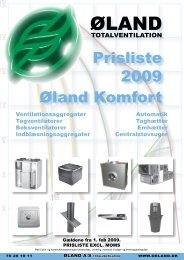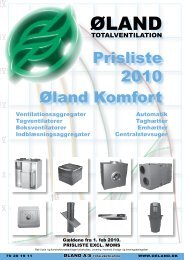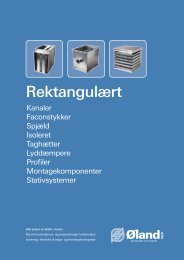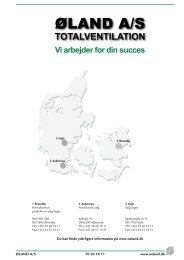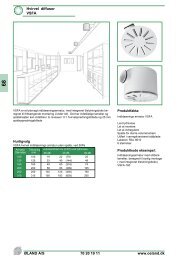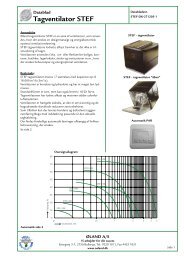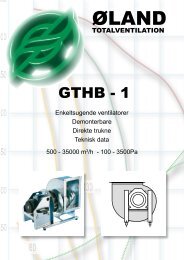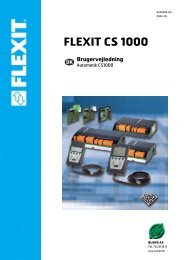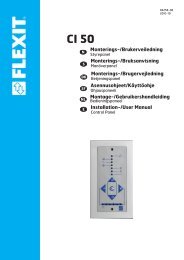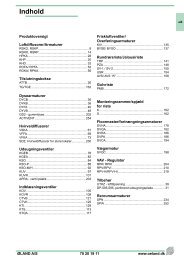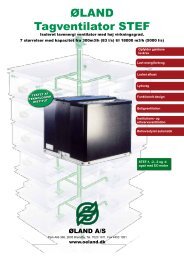IRIS-M
IRIS-M
IRIS-M
Create successful ePaper yourself
Turn your PDF publications into a flip-book with our unique Google optimized e-Paper software.
1. INSTALLATION<br />
Iris-M is delivered as a ready installable package. Do not remove the motor for<br />
installation or turn the motor when installing the damper in its place. These actions may<br />
have an effect on the mechanical functioning of the damper. During installation, beware<br />
of the sharp edges of the damper blades. Make sure the duct is sufficiently supported, so<br />
that no torsion is directed to a damper installed in a horizontal duct, and no weight<br />
caused by the duct is directed to a damper installed in a vertical duct.<br />
Iris-M is to be installed in<br />
the duct so that the damper<br />
position indicator is readable.<br />
To make sure no condensed<br />
water can flow from the duct<br />
to the motor casing, do not<br />
position the damper so that<br />
the motor is right underneath<br />
(Fig. 2).<br />
Leading the cables through the TET-membrane inlets:<br />
Pierce the membrane with the cable or a Phillips screwdriver.<br />
Push the cable through (1, Fig. 3).<br />
Secure the cable by pulling it back a bit (2).<br />
The cable penetration is now ready.<br />
Note! To make sure that the tightness class of the<br />
damper does not change, do not remove the membrane<br />
or pierce it unless you lead through a cable.<br />
The product must be installed so that it can<br />
easily be detached from the ducts.<br />
2. ELECTRICAL CONNECTIONS<br />
<strong>IRIS</strong>-M CONTROLLED WITH A HAND SWITCH<br />
- 3-POSITIONS SWITCH<br />
1 2 3 1 2 3 4 5 6 7 8<br />
1 2 3 4 5 6 7 8<br />
ELECTRICAL CONNECTION<br />
VIA SAFETY ISOLATING<br />
TRANSFORMATOR<br />
Fig. 2.<br />
Fig. 3.<br />
Do not connect your Iris-M to the power supply before installation, since the mechanical<br />
operation of an uninstalled damper poses a risk of bodily harm.<br />
The feeding of the 24 VAC supply voltage shall be arranged so that every damper<br />
/damper group can be cut off separately, e.g. by connecting the supply voltage to the<br />
wire with a plug connector (included in the delivery) connected to terminals 1 and 2 of<br />
terminal block J3 (see A in Fig. 1) or install a specific cut-off switch. For other electrical<br />
connections, just remove the plexiglass cover of the motor casing; the casing itself does<br />
not need to be removed. Terminals 3 and 4 (B) serve for sending control signals to the<br />
slave damper (if installed) connected in a cascade with the master damper.<br />
It is absolutely necessary that the slave damper supply voltage has the same<br />
polarity as the master damper supply voltage. Make also sure that all the other<br />
devices connected to the same power source (room regulators, carbon dioxide<br />
sensors, other <strong>IRIS</strong>-M dampers) have the same polarity.<br />
The control (instrumentation) cables shall be connected as shown in the wiring diagram.<br />
Motor-driven Iris dampers are controlled either with a hand switch (Fig. 4)or by external<br />
voltage or current signals (0...10 VDC or 4...20 mA). See Fig. 5. Control signals from a<br />
master damper to a slave damper are always current signals (4..20 mA).<br />
Fig. 4.<br />
The connections of jumpers J5, J7 and J8 (C) are determined by the control signal type<br />
used (D). If the damper is operated with the 3-position hand switch, all the three jumpers<br />
remain unconnected. However, the jumpers of Iris-M slave dampers are always<br />
connected in the same way (J5 and J8 connected) regardless of how the master damper<br />
is controlled.<br />
The switch is supplied via terminals 5 and 7 of terminal block J3, and control signals<br />
(2…10 V) from the switch are delivered via terminal 6 (Fig. 4).<br />
24 V AC<br />
D<br />
H<br />
G<br />
C<br />
A<br />
B<br />
J3<br />
24V~<br />
50...60Hz<br />
4,5W<br />
JUMPER SETTINGS<br />
J5 J7 J8<br />
q v max<br />
q v min<br />
J8<br />
J7<br />
J5<br />
ABB Fläkt Oy<br />
Div. Lapinleimu<br />
<strong>IRIS</strong>-M<br />
J3- 6 2...10VDC<br />
J3- 6<br />
J3- 6 4...20mA<br />
1 2 3 4 5 6 7 8<br />
24V AC<br />
4...20mA<br />
<strong>IRIS</strong>-M CONTROLLED WITH A SENSOR<br />
STEPLESS REGULATION MIN - MAX<br />
- CARBON DIOXIDE<br />
- HUMIDITY<br />
- TEMPERATURE<br />
+ -<br />
ELECTRICAL CONNECTION<br />
VIA SAFETY ISOLATING<br />
TRANSFORMATOR<br />
<strong>IRIS</strong>-M<br />
INSTALLATION, MEASUREMENT AND ADJUSTMENT<br />
10V DC<br />
JUMPER<br />
SETTINGS<br />
0...10 V DC<br />
2V DC<br />
JUMPER<br />
SETTINGS<br />
2...10 V DC<br />
ref.<br />
2...10VDC<br />
4...20mA<br />
q v<br />
IP 55<br />
TO ENVIRONMENT<br />
WHEN INSTALLED<br />
JUMPER<br />
SETTINGS<br />
4...20 mA<br />
DEFAULT<br />
SLAVE<br />
POWER<br />
OPERATION<br />
POSITION<br />
CLEANING<br />
POSITION<br />
SWITCH<br />
UNDER<br />
COVER<br />
A BB<br />
Kuva 1.<br />
1 2 3 4 5 6 7 8<br />
1 2 3 4 5 6 7 8<br />
F<br />
E<br />
I<br />
03.02.2006<br />
When the damper is controlled with a voltage or current signal, the connections are made<br />
as shown in Fig. 5. Make sure that the device used for controlling has the same polarity<br />
and the signal used for controlling has the same zero level as Iris-M.<br />
Fig. 5.<br />
Control signals are always sent to terminal 6, irrespective of the control signal<br />
type. The signal earth shall always be connected to terminal 8.<br />
Incorrect polarity of control signals and electrically too strong signals will cause<br />
damage to the damper!<br />
Before connecting the damper to the power supply, make sure that the jumpers are<br />
connected as the signal type requires by checking the motor signal lamps (the green one<br />
(E) shall be on continuously, a yellow one (F) only when the motor is running = max.<br />
three minutes) and the damper position indicator.<br />
Make sure that the cleaning switch (I) is in the right position (operation position)
3. MEASUREMENT AND REGULATION OF AIR FLOW<br />
Iris-M is designed so that all that needs to be removed before installing/adjusting the<br />
damper is the plexiglass cover of the motor casing. The casing may be opened with<br />
permission from the manufacturer only.<br />
If the damper is controlled with a 3-position manual switch, the<br />
minimum air change rate and the air change rate during<br />
forced ventilation are set with the trimmers (H and G) on the<br />
circuit board. First set the minimum air change rate with<br />
the q v min trimmer (G) and then the air change rate during<br />
forced ventilation with the q v min trimmer (H).<br />
The factory settings of Iris-M are 8 (minimum) and 2 (forced).<br />
The basic air change rate is set with the trimmer situated<br />
under the cover of the manual switch.<br />
(Fig. 6.).<br />
A regular two-way switch can also be used for controlling, in<br />
which case only two air change rates (min and max) can be<br />
used.<br />
If the damper is controlled with sensors (Fig. 5), minimum Fig. 6.<br />
and maximum air change rates are set, between which the<br />
air flow is adjusted according to needs. The air change rates are set with the trimmers (H<br />
and G) on the circuit board so that the minimum air flow is set with the control voltage<br />
value 0/2 V and the maximum air flow with the value 10 V.<br />
When setting air change rates, make sure that the operating switch is in the<br />
corresponding position or alternatively so that the control voltage value corresponds to<br />
the position being set. The min. and max. damper positions given on the scale must not<br />
be exceeded. The air change rate is defined according to the diagrams on basis of the<br />
pressure difference over Iris-M and the adjustment position. The pressure difference is<br />
measured from the manometer connections of the damper.<br />
4. SERVICE<br />
Before starting service operations, e.g. cleaning of the ducts, Iris-M must be fully opened<br />
(cleaning position) with the cleaning switch (I). To do this, remove the plexiglass cover of<br />
the motor casing. After completing the service operations, move the cleaning switch back<br />
to the original position (operating position) and fix the plexiglass cover back to its place.<br />
If the damper is installed close to a service hatch or duct end allowing access to the<br />
moving parts inside the damper, the service hatch or duct end must be provided with a<br />
sign indicating danger (SFS EN 294).<br />
5. TROUBLESHOOTING<br />
- Check the power connection to the device, the power light (E) is on.<br />
- Check that all devices connected to the system have the same polarity of supply<br />
voltage.<br />
- Check the correct position of the jumpers (D).<br />
- Check the position of the cleaning switch (I).<br />
- Check the value of the control current (0…10 V).<br />
Fläkt Woods Oy<br />
P.O.Box 6<br />
FIN-37801 Toijala, FINLAND<br />
Tel. + 358 20 442 3000<br />
Fax + 358 20 442 3502<br />
Pa<br />
,<br />
<strong>IRIS</strong>-M MEASUREMENT DIAGRAMS<br />
m<br />
p<br />
Pa<br />
,<br />
m<br />
p<br />
Pa<br />
,<br />
m<br />
p<br />
400<br />
300<br />
200<br />
50<br />
40<br />
30<br />
20<br />
10<br />
5<br />
400<br />
300<br />
200<br />
50<br />
40<br />
30<br />
20<br />
10<br />
5<br />
400<br />
300<br />
200<br />
50<br />
40<br />
30<br />
20<br />
10<br />
<strong>IRIS</strong>-M<br />
100<br />
5<br />
1 3 5 10 20 30 40 50 100 1 3 5 10 20 30 40 50 100 150<br />
q , l/s<br />
q , l/s<br />
<strong>IRIS</strong>-M<br />
160<br />
5 10 20 30 40 50 100 200 250 5 10 20 30 40 50 100 200 300 400<br />
q , l/s<br />
q , l/s<br />
<strong>IRIS</strong>-M<br />
250<br />
5 10 20 30 40 50 100 200 300 500 1000 30 50 100 200 300 400 500 1000 1400<br />
q , l/s<br />
q , l/s<br />
p = (q / k)<br />
m v<br />
2<br />
v<br />
v<br />
v<br />
Pa<br />
,<br />
m<br />
p<br />
Pa<br />
,<br />
m<br />
p<br />
Pa<br />
,<br />
m<br />
p<br />
400<br />
300<br />
200<br />
50<br />
40<br />
30<br />
20<br />
10<br />
5<br />
400<br />
300<br />
200<br />
50<br />
40<br />
30<br />
20<br />
10<br />
5<br />
400<br />
300<br />
200<br />
100<br />
50<br />
40<br />
30<br />
20<br />
10<br />
5<br />
<strong>IRIS</strong>-M<br />
125<br />
<strong>IRIS</strong>-M<br />
200<br />
<strong>IRIS</strong>-M<br />
315<br />
q = k p<br />
v m<br />
<strong>IRIS</strong>-M 1 1,5 2 2,5 3 3,5 4 4,5 5 5,5 6 6,5 7 7,5 8 8,5 min<br />
100 10,4 7,9 7,5 6,6 6,0 5,2 4,5 3,8 3,4 2,9 2,5 2,1 1,7 1,2 0,9 0,4 0,2<br />
125 13,8 10,4 8,8 7,3 6,5 5,5 4,7 4,0 3,5 3,1 2,7 2,2 1,5 1,0 0,9 - 0,5<br />
160 22,1 17,2 14,8 13,4 12,5 11,5 10,7 9,5 8,5 7,5 6,8 5,6 4,9 4,0 3,5 2,6 2,1<br />
200 44,2 36,6 30,9 26,9 23,2 20,6 18,2 15,9 14,0 12,3 11,0 9,6 8,4 6,5 5,0 3,0 1,1<br />
250 64,4 53,5 45,6 41,8 38,7 34,5 30,7 27,3 24,1 21,4 18,4 15,8 12,8 10,9 8,9 6,1 3,2<br />
315 118 88,3 70,0 64,5 58,7 53,0 45,1 42,4 37,0 33,3 30,0 25,9 21,8 19,0 15,8 12,9 10,3<br />
k<br />
v<br />
v<br />
v



